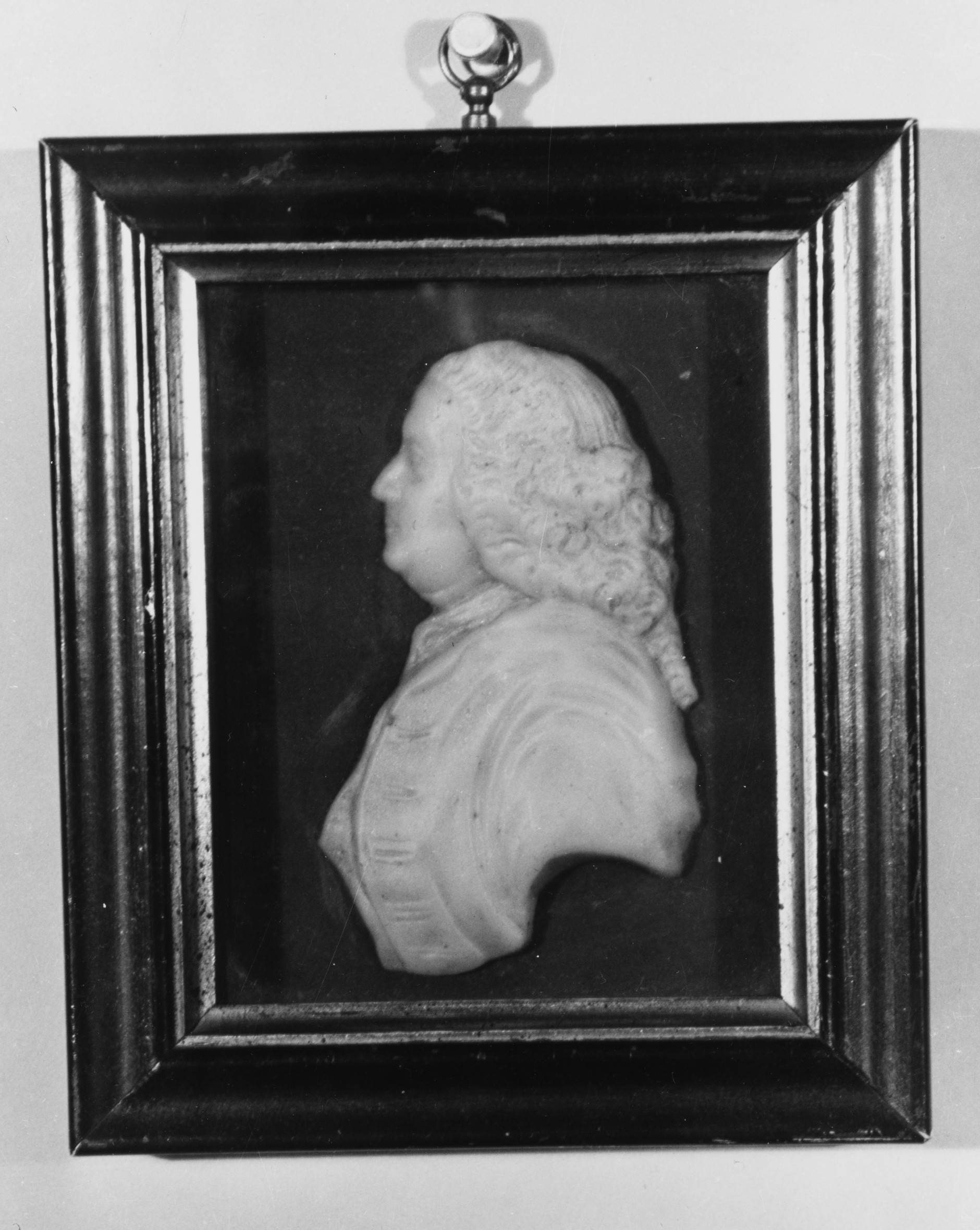Patience Lovell Wright
Active in: England, United States of America
Biography
Among the earliest American–born sculptors, Patience Wright helped pioneer and popularize realistic waxwork sculptures. Born Patience Lovell, the daughter of a Quaker farming family then living in Oyster Bay, Wright grew up in Bordentown, New Jersey. At sixteen, she left her family, moved to Philadelphia and in 1748, she married Joseph Wright, a barrel maker. Together they had four children: Elizabeth Wright (1749–1792); Joseph Wright fils (1756–1793), a painter; Phoebe (1761–1827), who married the painter John Hoppner (1758–1810); and Sarah, born in 1770.
Without any formal training, Wright evidently began sculpting by modelling faces out of putty and bread dough. Her ability to translate her sharp observation of a subject’s features into wax was reportedly so prodigious that visitors instantly recognized the individual represented, not only through her rendering of his or her face, but also their characteristic attitude and expression. In 1769, when Wright was 44 and pregnant with her fourth child, her husband died suddenly. Living in New York City with limited resources, she took up sculpture in earnest to support herself and her children. Her skills had developed sufficiently even before she was widowed. In 1766, Wright had made a wax anatomical specimen of Siamese twins for Dr. William Shippen, which the doctor sent to Benjamin Franklin (1706–1790) in London. After her husband’s death, Wright and her widowed sister, Rachel Lovell Wells (1735–1796), began to make wax portraits, promoting commissions and exhibiting their waxworks in New York and Philadelphia as a way of generating income through ticket sales.
Wright suffered a setback on June 3, 1771, when a fire at her home at 100 Queen Street, New York City destroyed all her work. By June 20, Wright and Wells had managed to recreate enough of the waxworks to continue their shows. In February of the following year, Wright set out for London where she began to make the first of several portraits of Benjamin Franklin. As she established herself in the capital, she began to receive commissions from various political figures, among them Prime Minister Lord North (1732–1792), former Prime Minister William Pitt the Elder (1708–1778), and John Wilkes (1725–1797), who had been kicked out of Parliament in 1764 for his libelous and pornographic writings. She made portraits of actors, like David Garrick (1717–1779), and artists, including the American painter Benjamin West (1738–1820), who had settled in London in 1763. Her fame rose such that King George III (1738–1820) and Queen Charlotte (1744–1818) had their portraits made by her. Wright fell out of favor at the court after the 1776 revolution, having been accused of spying for American revolutionaries.
Of the fifty-five works described by her contemporaries, only one survives today: her full-length portrait of William Pitt the Elder, known as the Old Commoner, who served as Prime Minister from 1766 until 1768. Wright befriended Pitt in London due to his support of the American colonies and after his death in 1778, she made a life-sized effigy for his tomb in the Chapel of St. John in Westminster Abbey.
Wright’s son, Joseph, was an artist who studied with Benjamin West (1738-1820) and John Hoppner (1758-1810) at the Royal Academy. In 1781, her daughter Phoebe married Hoppner and King George III withdrew his royal stipend due to the Wright family’s support of American independence. Wright moved to Paris later that year, where she lived until 1782. By 1783, she had returned to London and was in correspondence with George Washington (1732–1799) about a portrait bust commission.
Wright died on February 25, 1785, as the result of a fall that occurred as she made her way home from a visit to John Adams (1735-1826), who was acting as American ambassador to England. Her death was mentioned in several English and American newspapers. Among those who took note of her death was Horace Walpole (1717-1797), former member of Parliament, who, probably while at his home at Strawberry Hill, recorded her passing in his Book of Materials: “Mrs Wright from America, who modelled in wax as large as life & in colours, died in feb.1786”
Selected Works
Circle
Mother of
Joseph Wright <em>fils</em> (1756–1793)
Mother-in-law of
John Hoppner (1758-1810)
Friend of
Benjamin Franklin (1706–1790)
Friend of
Benjamin West (1738-1820)
Friend of
John Singleton Copley (1738–1815)
Friend of
John Adams (1735-1826)
Friend of
William Pitt the Elder (1708–1778)
Bibliography
Baetjer, Katharine. "British Portraits: In the Metropolitan Museum of Art". The Metropolitan Museum of Art Bulletin. 57.1 (1999): 1–72
Dabbs, Julia. Life Stories of Women Artists, 1550-1800. Farnham: Ashgate, 1988.
Sellers, Charles Coleman. “Patience Lovell Wright.” In Notable American Women, 1607-1950, edited by Edward T. James and Janet Wilson James, 685-87. Cambridge: Harvard University Press, 1971.
Sellers, Charles Coleman. Patience Wright, American Artist and Spy in George III’s London. Middletown, CT: Wesleyan University Press, 1976
Waska, Frank E. “Mrs. Patience Lovell Wright. A Famous Modeler in Wax.” Brush and Pencil 2.6 (Sept. 1898): 249-52.
Entry Notes
For Judy Simic, art lover and museum supporter, who is something of a pioneer herself, I affectionately dedicate this entry on Patience Wright, a pioneering artist.—Heidi Gealt

